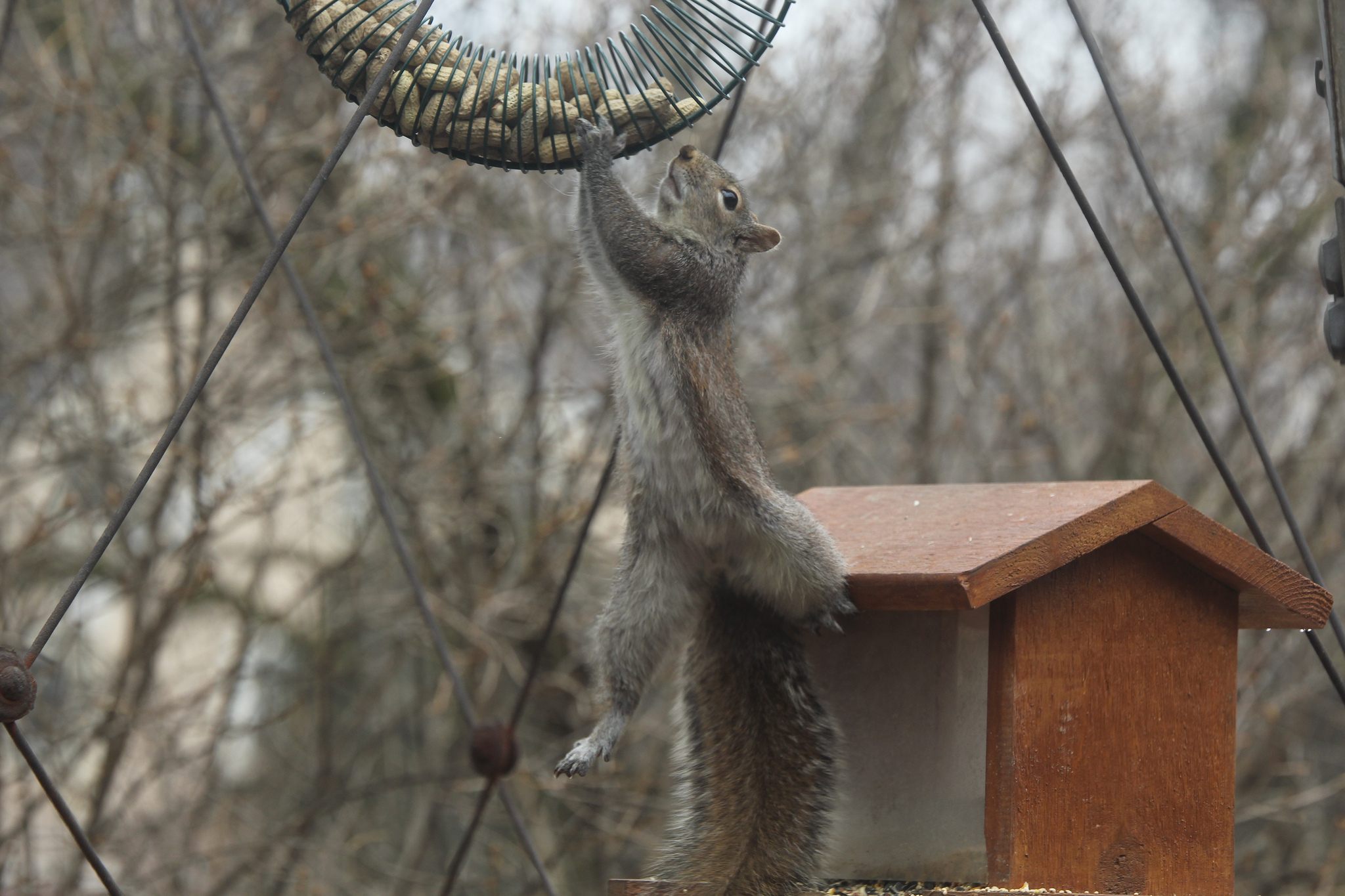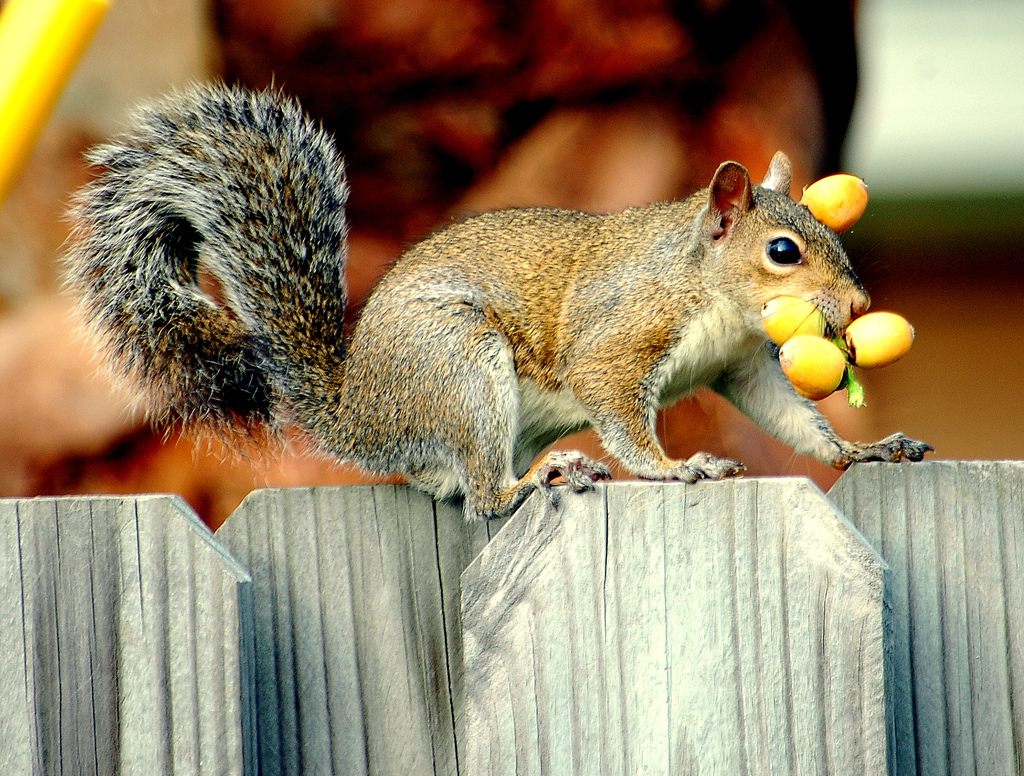Is A Squirrel Smarter Than A Fifth-Grader?
 An eastern gray squirrel reaching for a bird feeder while upside down. (Photo: waferboard/WikiCommons CC BY 2.0)
An eastern gray squirrel reaching for a bird feeder while upside down. (Photo: waferboard/WikiCommons CC BY 2.0)
They can defeat just about any attempts to block them from feasting on bird feeders and thrive in the biggest, toughest cities in North America. These creatures have figured out how to use people for their own benefit, and have even, extremely rarely for animals, been documented exhibiting deceptive behavior.
Prepare to consider squirrels in a whole new light.
“Sometimes I think that squirrels are North America’s version of monkeys,” says Steve Sullivan, curator of urban ecology for the Chicago Academy of Sciences and Peggy Notebaert Nature Museum as well as the head of Project Squirrel, a citizen science project that tracks the various species of squirrels. But just how smart are they, really?
 An eastern fox squirrel. (Photo: Dawn/flickr)
An eastern fox squirrel. (Photo: Dawn/flickr)
The squirrel family is a big and varied one, including ground squirrels like prairie dogs and marmots (giant beaver-like squirrels that mostly live in alpine environments). Most Americans know the tree squirrel, the many and very widespread species of rodent with puffy tails, fantastically acrobatic movements, phenomenal adaptability to urban environments, and very cute little faces. There are a whole bunch of species and subspecies of squirrels in North America, but the most common are the eastern grey squirrel and the fox squirrel, both of which started out in the eastern third of the continent but are now found coast to coast.
The eastern grey and fox squirrels are widely studied; earlier this summer a big conference, the 7th International Colloquium on Arboreal Squirrels, was held in Helsinki, Finland. Studies routinely come out that discover new, amazing behaviors, especially involving the squirrel’s signature behavior, that it buries caches of its food for later. One experiment found that they’ll try multiple tactics to open a locked box. Another found that squirrels really do remember the location of their caches, that they aren’t merely using their keen noses to locate them. Another found that they’re able to quickly learn from their peers.
And perhaps most interestingly, a 2010 study found that squirrels actually engage in deceptive, or paranoid, behavior. When squirrels are being watched, they’ll construct fake caches, pretending to bury a nut, going through the whole rigamarole of digging a hole, patting it down with their front teeth, and scraping dirt or grass over the top of it. They’ll actually be concealing the nut in a pocket near their armpit, and will make the real cache somewhere else. Even when you’re watching for it, it can be hard to tell when a squirrel is making a fake or a real cache. So, how smart is that?
The first big wrench in that question is the word “smart.” Animal intelligence is something we humans are fascinated with, whether it’s teaching the dog a new trick or marveling at the social behavior of octopuses. Animal intelligence stories make headlines constantly. Yet, it’s still not well understood. “We kind of interpret that as, how would they do on the same IQ test that my 7-year-old just took?” says Sullivan. “And the answer to that is, 100 percent of every other species would do pathetically on it. But that doesn’t mean your kid can climb a tree as fast as a squirrel can, or can observe a hawk and identify its characteristics as quickly as a squirrel can.”
Intelligence, among squirrel experts, is not a particularly useful or meaningful concept. When we humans discuss intelligence, we could be referring to a whole host of not-always-related topics: problem solving, abstract thought, creativity, memory retention. A 2006 paper found a whopping 71 different definitions of intelligence scattered amongst scientific literature.
 An eastern grey squirrel. (Photo: Robert Engberg/flickr)
An eastern grey squirrel. (Photo: Robert Engberg/flickr)
Tests for animal intelligence usually involve problem solving and memory: can a rat remember a route through a maze? Can a crow figure out how to use a bent piece of wire to fetch food? But those are tests that we conceive of because, frankly, they’re tests that we’d do well on. “Humans are very visual, so we assume that’s how animals solve problems, by using what they see in the world,” says Mikel Maria Delgado, a doctoral student at the University of California, Berkeley who studies the university campus’s population of fox squirrels. “But we know that other animals have much better senses of hearing, senses of smell, touch, sensation, like animals with whiskers, and humans can’t do a lot of those things very well so we don’t consider that criteria for being intelligent.”
It’s easy to assume squirrels aren’t smart because they can’t, say, use tools to bury nuts. Like a lot of assumptions about what makes an organism intelligent, that assumes that intelligence is equal to how similar an animal’s cognitive process is to ours. But what if we go the other way around, and play by the squirrel’s rules?
Delgado conducted a study in which students were placed in a competitive game to act like squirrels. They were tasked with hiding caches of plastic eggs, and then 15 minutes later tasked to go back out and bring back as many eggs as possible. They could locate their own caches or steal from those of other students, the same way squirrels do. This is a very squirrel-like test: memory, deception, location, observation, paranoia.
So how did the students do? “People are pretty bad at it,” laughs Delgado. “It really gives people an appreciation for the problems that squirrels are solving.” Most couldn’t remember their own hiding places. Squirrels bury about 10,000 nuts per year, and the most populous species, the eastern grey and the fox squirrel, make many, many different caches, and may not uncover them for months. They may dig up a cache and bury it somewhere else, and do that up to five times. And squirrels, unlike UC Berkeley students, are engaged in this intellectually draining activity while also avoiding predators and braving the elements.
 An eastern grey squirrel hoarding palm dates in Florida. (Photo Jamie Drake)
An eastern grey squirrel hoarding palm dates in Florida. (Photo Jamie Drake)
A major obstacle to coming to a measurement of animal intelligence is that animals don’t really have very much leisure time in the wild; decisions are made in the name of efficiency, making sure the amount of calories burned is fewer than the amount of calories ingested. “All animals have evolved to solve certain problems and they’re usually really good at that,” says Delgado. But those problems aren’t necessarily the ones we’d pick if giving an intelligence test. “You’re only as smart as your ecology requires you to be,” says Sullivan.
A major element to the perceived intelligence of squirrels is their ability to live and even thrive in urban environments. This is sort of an element of the basic human understanding of intelligence as “similarity to us,” but there might be something to it. After all, doesn’t the ability to adapt to a fast-growing, extremely unnatural construction like a city demonstrate intelligence for an animal that hasn’t evolved to live in that environment?
 A fox squirrel. (Photo: Ingrid Taylar)
A fox squirrel. (Photo: Ingrid Taylar)
Not necessarily. “They’re really sort of pre-adapted to urban areas,” says Sullivan. “A telephone line is, to them, no different than a sassafras tree. A telephone line and a sassafras tree both have long spindly branches that poke out, that you can run across to get to safety. But they don’t offer food or much in the way of safety.” It’s not so much, suggests Sullivan, that squirrels adapted to urban life, but that the skills and abilities squirrels already had just so happened to be a good fit for cities. It’s the same story for pigeons. Urban pigeons are typically feral descendants of domesticated rock pigeons, a bird species that prefers to live and nest on small ledges on the sides of cliffs. They prefer tiny, hard outcroppings on steep vertical environments. So when we built skyscrapers with ledges, it wasn’t that pigeons adapted to cities—it was like we built a gigantic perfect mansion, just for them.
Socialization is often cited as a building block of intelligence. Squirrel social behavior is not really that unusual in a lot of ways. Unlike their ground squirrel cousins, tree squirrels like the eastern grey and the fox squirrel are solitary, living alone, raising young only briefly, and communicating in a range of vocalizations and body movements. (That chittering sound you hear from above, by the way, means “you’re close to my food cache, get the hell out of here.”) The only really unusual attribute thus far discovered is the squirrel’s ability and propensity to deceive other squirrels. But is that a sign of intelligence or simply an element of instinct? Very hard to say.















Follow us on Twitter to get the latest on the world's hidden wonders.
Like us on Facebook to get the latest on the world's hidden wonders.
Follow us on Twitter Like us on Facebook